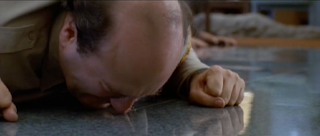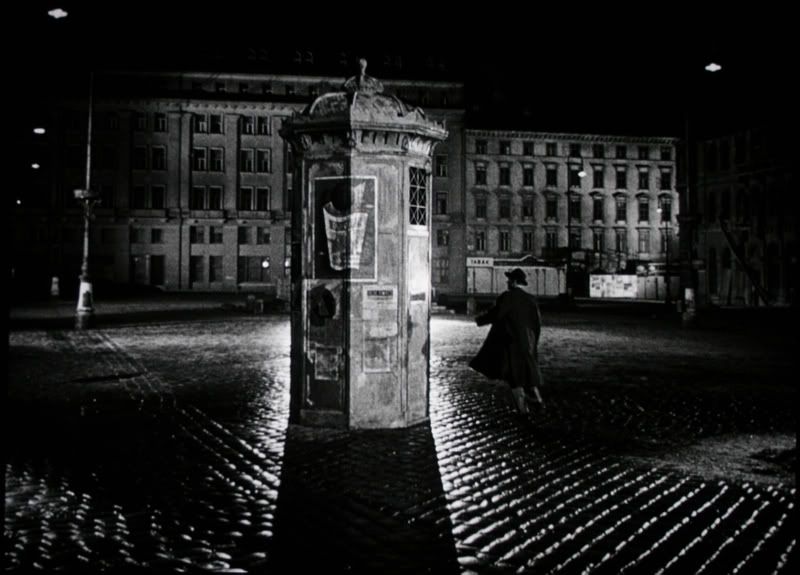If you've never seen Point Break, you should see it. In fact, you should stop reading this article and watch it right now. Now, I don't mean to imply that Point Break is a good movie- it isn't. It's actually pretty dumb. But I would argue that Point Break is one of two things:
1) The least self-aware movie I've ever seen.
2) The most self-aware movie I've ever seen.
Let me explain. Point Break stars Patrick Swayze and Keanu Reeves in someone's idea of
Reeves plays a special agent named Johnny Utah who has to infiltrate a gang of surfing bank robbers and proceeds to skydive, party, and rob his way into their hearts. He is also the quarterback for their beach football team. I AM NOT MAKING ANY OF THIS UP. The best thing about Point Break is that director Katheryn Bigelow conducts all of this with a sort of straight-faced solemness, as if she were directing a movie on par with Citizen Kane. There's this weird tension between her somber direction and the preposterous source material. It's difficult to know whether Point Break wants you to interpret it seriously, or whether the heavy mood and deadpan presentation are part of the joke.
This may all seem a bit boring or scholarly, but it's all I could think about when I watched this sequence a few months ago. The bank robbery scene as follows is top-notch in editing, direction, and cinematography. It's also part of a terrible movie.
http://vimeo.com/16071047We start with a shot of the van as it approaches the bank. You can vaguely make out three of our five bank robbers, complete with creepy president masks.

From there, we cut to the back of the van, pulling into frame on a fairly busy street scene. The color palette is pretty muted, just as it is throughout the whole film. Note how long the shot is held- we're building tension here. Then, a cut to Keanu Reeves as Johnny Utah, delivering another one of his powerhouse performances. He looks pretty concerned.

Don't worry, Keanu. Everything's gonna be okay. Now, dear readers, if ever I tell you that Point Break is a good movie, it will be on the strength of the following shot. This is a whiz-bang shot, so pay attention. We start off with a shot of Patrick Swayze adjusting his mask (Ronald Reagan, of course), and turning around to give Keanu a hearty "Rock and roll!"

Then the camera follows him out the van-

-and into the street, where it pans up quickly to show us the bank sign-


-and into the bank, where we focus first on Patrick Swayze, before panning over to Jimmy Carter with a shotgun in some poor chump's face-


-then over to LBJ, in a full run, who is soon joined by Richard Nixon-


-before Nixon splits on his own-


-and the camera pans over to end with a POV shot from Keanu's point of view, showing the poor victim he's threatening.

Watch it again. Like I said, a real whiz-bang shot. From here, Keanu shouts at this guy, he lays down on the floor, and then Swayze comes back into view, directing Keanu's attention to a security camera. Again, cinematographer Don Peterman uses a single long shot, panning from our anti-heroes to the cameras and back.




Aww, Keanu. :(
Swayze then runs up and hops on top of a counter, shouting at everyone and trying to intimidate them. Notably, we see a CU on gloved hands grabbing cash- we'll see this shot again soon.

Then Bodhi (Swayze's character) decides to hit the vault. This is an important story point, because the Ex-Presidents have always left after taking the money from the cash registers. Pulling money from the vault means they spend more time in the bank, which means more things can go wrong. In other words, Bodhi is getting greedy and risky.
This reaction shot from the Nixon mask cracks me up every time I see it.

From there, we cut to a shot of Bodhi as Reagan, the camera circling him uncertainly. He singles out a bank employee and demands that she open the vault. She refers him to one Mr. Duggins, who apparently serves as keymaster and gatekeeper of the bank. Bodhi has a polite conversation with him-

-and charms him right into giving up the vault key. A quick cut to a very disapproving Keanu, and we're off with another long, unbroken shot as Nixon heads off to the vault. Note LBJ hopping the desk in the second shot.





Notice the camera move past the characters and towards the money, zooming in again on gloved hands as they grab at it. There's a strong emphasis on the money being taken. This serves two purposes: first, it emphasizes the forceful nature of the bank robbery, and second, it serves as an illustration for Bodhi's greed.



When the cut finally comes, it's to another angle on gloved hands grabbing at the money. Then, from this relatively dark shot, we cut to an innocent bystander walking through the bright glass doors, only to be thrown down by Jimmy Carter. Then we see Keanu, delivering a performance that reminds us why he is one of the greats.

"Ugh, dude, you're something something too much time!" he shouts. Patrick Swayze assures him everything will be fine, but Keanu angrily walks away. Here comes another pretty cool shot: first, we see Keanu's feet-

-before the camera slides past everyone lying on the floor to focus on two new characters-


-and yeah, that
is Kevin from The Office. The guy in the grey sweater tells Kevin from The Office that he's a cop, and reveals his gun.

This makes Kevin from The Office very sad.


The cop in the grey sweater and Kevin from The Office jump up and initiate a shootout. This goes by extremely quickly, and I'll just give a brief synopsis: Grey Sweater hits Bodhi (Patrick Swayze), knocking him down. Earlier, we see our bank robbers putting on bulletproof vests, so we know he's fine, but that is unknown to everyone else.


Grey Sweater turns around and shoots Keanu Reeves, despite his whole "I'm an FBI agent, honest!" routine.

At this point, Jimmy Carter takes a shot at the cop, and the cop goes down. Kevin from The Office starts shooting wildly at Jimmy Carter. (I bet no one else's analysis uses those words.)

Jimmy Carter does a pretty sweet hop-roll behind a desk, and LBJ hops the desk and plugs Kevin pretty good. Unfortunately, his injuries ensure that he'll spend the rest of his days in a droll office cubicle, putting up with hijinks from his wacky co-workers.

Grey Sweater turns around and shoot Nixon in the vest, causing him to fall over. He then hits LBJ in the throat-
above the bulletproof vest. LBJ goes down, and know he's done for. Then comes a great shot...

Up from behind the counter rises Ronald Reagan, the mask shadowed and grotesque. He pulls off his mask to reveal the sun-bleached locks of Patrick Swayze...
angry Patrick Swayze.


The cop fumbles to try and get his gun ready, but he knows that he is completely and totally boned. You tell just by the look on his face.

Swayze shoots the cop, and we see Keanu pull off his shirt to reveal his vest with two impact marks. The shot lingers for longer than you might expect, bringing the energy level down as it shows Keanu's shock at being shot. (I refuse to acknowledge the name Johnny Utah.)


In one final long shot, Bodhi jumps over the table and kneels to pick up his fallen comrade. He picks him up and hobbles away.





To sum up, director Katheryn Bigelow and cinematographer Don Peterman use long handheld takes and a desaturated color palette to give the sequence a documentary feel. This heightens the intensity of the scene because the audience perceives it as being "real." (Well, maybe not Keanu Reeves' performance...)























































